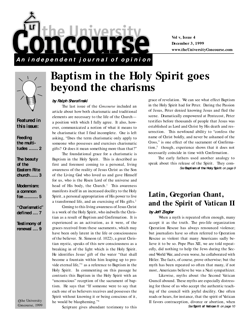The blessings of both sides: a personal testimony
by Sr. Jane M. Abeln, SMIC
Thanks, Carole Brown, for your thorough and balanced article in the Nov. 10th issue of the Concourse, complete with quotes and citations from popes and Church documents.
When four students eloquently and passionately shared their foundations in traditional or charismatic spirituality during the opening HOPE weekend of the Fall semester, I resonated with facilitator Dr. Andy Minto’s words afterward: “something of each one’s journey fits into mine.”
My father was a very traditional Catholic daily Mass-goer (with St. Joseph’s missal in English and Latin columns.) My mother, a convert from friendly Methodism with a charismatic heart, did not blossom in traditional Catholic parish worship. My own search for purpose in life was moved by the famous “know, love, serve God” Baltimore Catechism answer. By age twelve, I had tasted the fear of losing all through a dubious “big sin,” and had determined to live my life from the perspective of eternity.
After high school, I entered the convent. My primary desire was for a lifetime relationship with Jesus, who took me on a Postulancy honeymoon in which Scripture came alive and I was filled with longing to pray in chapel and make sacrifices for love of Him. But there were missing elements, which eventually caused set-backs in my religious life. I never shared my journey with the saintly Sisters living in my large community; nor did they share their “secrets of the King” with me. Practical responsibilities crowded in and a spiritual dryness settled over me. Where were the peace, love and joy I was longing for as a religious? A decision made not understanding or following good discernment guidelines brought me near despair, because though I wanted God’s will, I felt I did not find it.
The charismatic renewal knocked during a night-long reading of David Wilkerson’s The Cross and the Switchblade. It supplied what I was longing for. Wilkerson at least was one other person who believed that relating to Jesus was primary, and ministry flowed out of that.
The charismatic renewal in the Catholic Church opened me up to spiritual realities I hadn’t even known enough to dream of: prophecies and words of knowledge, prayer for healing that effected changes, and the power to witness. Now I understood how to listen to the Holy Spirit in discernment, so that when a new major decision came before me, I could discern clearly.
At the FUS HOPE that Saturday morning in September, I agreed with all the speakers. Two students eloquently shared the Church’s rich tradition of prayer, sacred music, liturgy and contemplation—meant for every Catholic and local community. Two affirmed how the charismatic gifts, reaffirmed in Vatican II and experienced since then, also have a vital role for all that the Church is meant to be. I rejoiced when Susanna Summers told how her parents who had left the Church came back through the charismatic renewal, and were led by the Holy Spirit to sell all their possessions and go on missions to foreign lands, where they continue to help others open to dynamic faith.
My own experience has taught me that without the charismatic, the tradition can be “frozen” and lacking some fire. But now, as new younger people actually grow up in charismatic families, if they have not also the rich tradition, they too can lack the fullness of the Catholic experience.
Sometimes, as in historical and literary movements, there can be an extreme pendulum swing at first. Perhaps this is why those who remember Franciscan University’s campus when it was newer in the charismatic dimension can think that the fervor is dying or slumbering now. But if we assess maturity as integration and balance, as Carole Brown presented it, then it seems to me instead that this campus—which is now twenty-five years into its charismatic-renewal life—is naturally reaching the young-adult period where it wants to court and marry the tradition. May it bear and raise new children, who breathe with both lungs and walk on both feet, freely endowed with the gifts of both parents.
Sr. Jane teaches freshman English at FUS.


